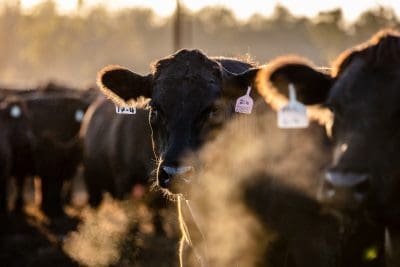AS PART of one of the four key work areas in relation to the beef industry’s Carbon Neutral 2030 Roadmap referring to greenhouse gas emissions from livestock, it has been discovered that the current equation used to determine the levels of enteric methane emissions from feedlot cattle may overestimate the numbers.
 Currently, a 1979 vintage equation developed by Moe & Tyrell is used to calculate enteric methane emissions from feedlot cattle as part of the National Greenhouse Inventory. These calculations are then reported as part of Australia’s obligations under the United Nations Framework Convention on Climate Change and Paris Agreement.
Currently, a 1979 vintage equation developed by Moe & Tyrell is used to calculate enteric methane emissions from feedlot cattle as part of the National Greenhouse Inventory. These calculations are then reported as part of Australia’s obligations under the United Nations Framework Convention on Climate Change and Paris Agreement.
The Moe & Tyrell equation was developed using North American dairy cattle in the late 1970s. Originally it was chosen due to its reliance on the carbohydrate composition of each diet, offering the potential for customised estimates for different feedlots.
Meat & Livestock Australia has now completed projects where actual collected data from Australian feedlot cattle does not accurately reflect predicted methane emissions calculated using the 1979 equation.
Clues from long-term data
In 2016, an MLA project led by researchers at the University of Melbourne investigated the long-term total greenhouse gas emissions from beef feedlot cattle.
This project involved collection of emissions data at two feedlots, one in southern Australia and one based in northern Australia. A low-resolution closed-path Fourier transform infrared trace gas analyser mounted to a tower was used to measure methane, nitrous oxide and ammonia emissions of the whole feedlot ecosystem over a three-year period. Two towers were strategically placed at each feedlot.
The emissions data collected from the towers was compared to the national inventory quantification methods. Significantly, it was shown that equations used to predict methane and nitrous oxide resulted in an overestimation of up to 30pc and 80pc, respectively, depending on the site.
One of the University of Melbourne researchers involved in the project, Deli Chen, said he wasn’t surprised by the findings.
“We weren’t surprised because it was a long-term measurement and there was limited long-term data available,” he said.
“The current inventory equation is also based on short-term, smaller animal chamber measurements which had been extrapolated.”
Mr Chen reiterated that this project was completed at only two feedlots, adding that the northern locale was subtropical while the southern feedlot was more similar conditions to that of Northern America, where Moe & Tyrell’s 1979 formula was developed.
“Feedlots are giving smaller total emissions than other areas of the cattle industry, such as dairy cattle, but the difference is that the process is more intensive over shorter-term,” he said.
“Due to the shorter-term, there is more potential to be able to manage those emissions more than other parts of the production system.
“Large-scale, long-term measurement is essential. Continued investment and research into the emissions of the feedlot industry are important, to help find the most efficient way to not only record methane emissions but also how to mitigate other GHGs, in particular N2O and indirect GHG emissions, of NH3 from animal manure management to assess the total GHG emissions.”
Continued evidence
The findings of the project provided evidence to other researchers’, including Fran Cowley, Associate Professor of Livestock Production at the University of New England, that there may be better ways to predict emissions from feedlot cattle.
Further research was conducted as part of another project in 2020 by UNE and funded by MLA: Methane emissions of Australian feedlot cattle as influenced by 3-Nitrooxypropanol (Bovaer). The findings showed an overprediction of 60pc by the Moe & Tyrell equation that equated to 95.5g/day of methane.
“This was a small-scale project where we only used a few animals as part of the control group. To collect data, we took the control animals, and placed them in our gold standard respiration calorimeter facility,” Prof Cowley said.
“Although it was only a small control group, the data that was collected was high quality and supported the suspicions that the accuracy of the equation was not holding up for Australian beef cattle on a typical Australian feedlot diet,” she said.
Prof Cowley noted that with the Moe & Tyrell equation, there was a very different physiology in play.
“We’re also talking about an equation which is based on 50-year-old genetics, which may make it inappropriate to use the equation for dairy cows let alone for feedlot cattle – North American Dairy cow diets are also very different to that of Australian feedlot cattle.”
The future
When asked what this meant for producers and the industry, Prof Cowley said a lot of this was a future-proofing exercise – providing support to grain feeding being a method of reducing the carbon footprint of beef.
“The feedlot industry is an important way that we can work towards a carbon-neutral food production system,” she said.
“In the future, I think it’s highly likely that we will see an environment where there will be a price on market access on carbon. Being able to have a more accurate and lower estimate of the emissions and carbon footprint of feedlots is going to ease potential issues accessing markets that require no or low emission product.”
Prof Cowley reinforced the importance of producers continuing to adopt best practices, with the research reinforcing the importance of feeding more efficiently and making sure that every mouthful of feed that cattle are consuming is being turned into more beef.
“Focusing on a more energy-dense formulation is going to help contribute to a lower carbon footprint,” she said.
Source: MLA

HAVE YOUR SAY